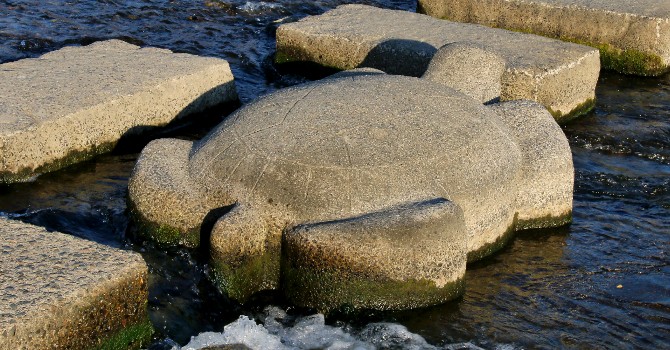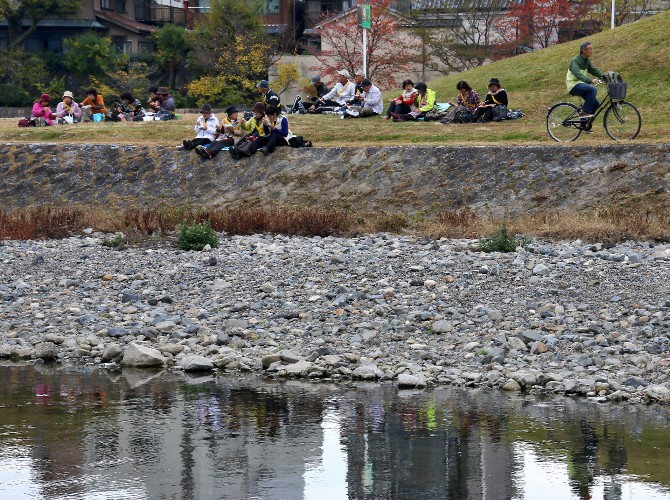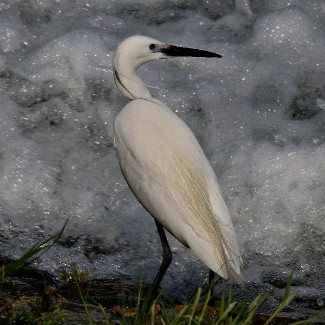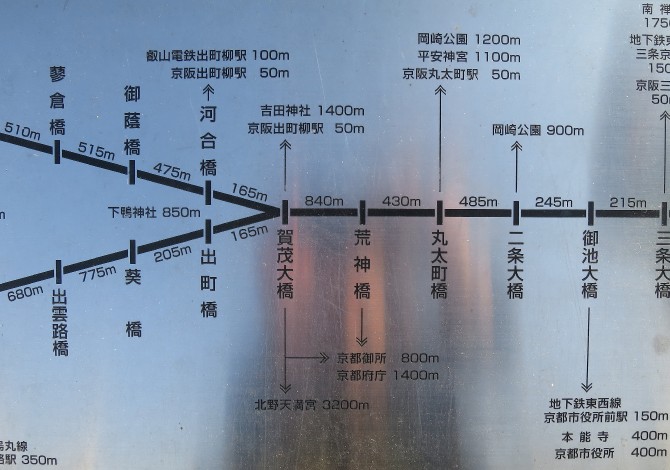KAMO RIVER, Kyoto, Japan |
||
 |
||
Turtle-shaped stepping-stones. Photo by Derek Irland |
||
————————————————————————————————— This essay was originally posted to National Geographic's Water Currents blog on April 1, 2015. —————————————————————————————————
I have heard that some communities are not very friendly to their rivers, but many friends everyday walk the paths along my shores, ride bikes, have picnics, push baby strollers, and bask in the colors of the nearby trees with cherry blossoms in spring, and red maple leaves in fall. I flow next to the old geisha district of Gion, with women still wearing traditional kimonos. I am certainly not considered a beautiful free-flowing river, but I function as a respite from the pace of urban life in Kyoto, (although nothing compared to downtown Tokyo). |
||
 |
||
Enjoying a picnic on the riverbank. Photo by Derek Irland |
||
In Japanese I am called Kamo-gawa, (kanji compound 鴨川). Translated from the kanji my name means “wild duck,” and “gawa” is river. Not only ducks, but also a large variety of birds wade in my shallow waters in search of their next meal. Herons and egrets wait patiently as they stalk their food. |
||
 |
 |
|||
Little Egret (Egretta garzetta). Photo by Derek Irland |
Grey Heron (Ardea cinerea) with a snack. Photo by Derek Irland |
|||
My source is in the mountains of Mount Sajikigatake in the northern ward of Kyoto. With a length of just 19 miles (31 km), I flow into the Katsura River south of downtown Kyoto and after joining with other river systems we eventually make our way out into Osaka Bay. My depth is shallow, being only three feet in most places until the rainy season when some pathways are drenched. In the fall, surrounded by the vibrant vermillion of the local trees, a person could walk across my width and only get their ankles wet.
Where the Takano River converges with my flow there is a triangular area of land honoring the river confluence at the Shimogamo Shrine near a forest. Upon making a donation to the shrine, monks give visitors a cloth-wrapped white rock, which is taken to a small stream where it is washed and purified. The stone is rewrapped in the cloth, carried to woven bamboo baskets and placed among other blessed stones that will be used in the reconstruction of ritual sites. |
||
 |
||
Purifying rock with water at the Shimogamo Shrine. Photo by Derek Irland |
||
Purification is important to Shinto, so throughout the year there are numerous ceremonies held at this and the many other Shinto Shrines in Kyoto. Also, the Buddhist Temples hold annually rotating ceremonies, so there is always activity in Kyoto at the immaculately groomed gardens of the shrines and temples.
Unlike other rivers in Japan, I am not buried under cement, so it is gratifying indeed to be able to see all the locals who enjoy visiting me regularly. And at night I am illuminated and set aglow with lights from bridges, buildings, and stone lanterns. Not to boast, but I am sometimes referred to as one of the treasures of Kyoto, even though I am only fourth in length.
But I do miss natural meanders, since my course is within a channel and my flow is an unnatural straight line. Roughly 30 bridges cross over my southern stretch carrying buses, cars, trains, and pedestrians. |
||
 |
||
Diagram of bridge locations on channelized Kamo-gawa. Photo by Derek Irland |
||
Near the Imadegawa Dori Bridge there are chunkily cast concrete stepping-stones crossing my back (as there are at several other locations). The most prominent shape of the stones here is in the form of turtles. Children wearing school uniforms and backpacks hop fast from stone to stone while elders worry about how to step gingerly from one to another with the water flowing by underneath.
Instead of being on the shore, these stepping stones bring people of all ages right to me so I hear laughter and conversations up close as they zig-zag across me, or sometimes just choose a stone and sit quietly for awhile. |
||
next page: Siem Reap River >
< previous page: Eagle River




































